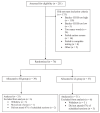Is more better? Milieu communication teaching in toddlers with intellectual disabilities
- PMID: 23275404
- PMCID: PMC3733661
- DOI: 10.1044/1092-4388(2012/12-0061)
Is more better? Milieu communication teaching in toddlers with intellectual disabilities
Abstract
Purpose: The authors sought to determine whether a program of 5 weekly doses of milieu communication teaching (MCT) would yield improvements in children's communication and word use compared with a once-weekly delivery of the same treatment.
Method: Sixty-four children with intellectual and communication delay were randomly assigned to receive 60-min sessions of MCT either 1 time or 5 times per week over a 9-month treatment. Growth curves were fit to data collected at 5 points before, during, and after the MCT was delivered.
Results: With groups collapsed, significant growth across the experimental period was observed on all measures, but this was not associated unconditionally with treatment intensity. Children who played with 9 or more objects during a standard play assessment, an empirically identified cut-point, benefited more from the high- than from the low-intensity treatment on lexical measures (Hedges's g range = .49 to .65).
Conclusions: More MCT is not always better for all children. Clinicians can expect that increasing the frequency of MCT sessions will yield moderate enhancement of outcomes if the child has high interest in objects.
Keywords: children; communication; developmental disorders; early intervention; efficacy; intervention; language disorders.
Figures


Similar articles
-
Parent-implemented enhanced milieu teaching with preschool children who have intellectual disabilities.J Speech Lang Hear Res. 2013 Feb;56(1):295-309. doi: 10.1044/1092-4388(2012/11-0231). Epub 2012 Jun 28. J Speech Lang Hear Res. 2013. PMID: 22744141 Free PMC article. Clinical Trial.
-
Effects of dose frequency of early communication intervention in young children with and without Down syndrome.Am J Intellect Dev Disabil. 2014 Jan;119(1):17-32. doi: 10.1352/1944-7558-119.1.17. Am J Intellect Dev Disabil. 2014. PMID: 24450319 Free PMC article. Clinical Trial.
-
A transactional model of spoken vocabulary variation in toddlers with intellectual disabilities.J Speech Lang Hear Res. 2014 Oct;57(5):1754-63. doi: 10.1044/2014_JSLHR-L-13-0252. J Speech Lang Hear Res. 2014. PMID: 24802090 Free PMC article. Clinical Trial.
-
Parent-mediated interventions for promoting communication and language development in young children with Down syndrome.Cochrane Database Syst Rev. 2018 Oct 15;10(10):CD012089. doi: 10.1002/14651858.CD012089.pub2. Cochrane Database Syst Rev. 2018. PMID: 30321454 Free PMC article. Review.
-
Communication interventions for autism spectrum disorder in minimally verbal children.Cochrane Database Syst Rev. 2018 Nov 5;11(11):CD012324. doi: 10.1002/14651858.CD012324.pub2. Cochrane Database Syst Rev. 2018. PMID: 30395694 Free PMC article.
Cited by
-
Joint engagement and early language abilities in young children with Down syndrome.Front Psychol. 2023 Apr 28;14:1152559. doi: 10.3389/fpsyg.2023.1152559. eCollection 2023. Front Psychol. 2023. PMID: 37207029 Free PMC article.
-
Teaching Preschoolers With Down Syndrome Using Augmentative and Alternative Communication Modeling During Small Group Dialogic Reading.Am J Speech Lang Pathol. 2020 Feb 7;29(1):80-100. doi: 10.1044/2019_AJSLP-19-0017. Epub 2019 Nov 7. Am J Speech Lang Pathol. 2020. PMID: 31697898 Free PMC article.
-
Targeting Complex Sentences in Older School Children With Specific Language Impairment: Results From an Early-Phase Treatment Study.J Speech Lang Hear Res. 2018 Mar 15;61(3):713-728. doi: 10.1044/2017_JSLHR-L-17-0105. J Speech Lang Hear Res. 2018. PMID: 29490376 Free PMC article.
-
Caregiver-Implemented Communication Interventions for Children Identified as Having Language Impairment 0 Through 48 Months of Age: A Scoping Review.J Speech Lang Hear Res. 2022 Aug 17;65(8):3004-3055. doi: 10.1044/2022_JSLHR-21-00543. Epub 2022 Jul 19. J Speech Lang Hear Res. 2022. PMID: 35858263 Free PMC article.
-
How to Study the Influence of Intensity of Treatment on Generalized Skill and Knowledge Acquisition in Students with Disabilities.J Behav Educ. 2015 Mar 1;24(1):152-166. doi: 10.1007/s10864-014-9216-6. J Behav Educ. 2015. PMID: 25914513 Free PMC article.
References
-
- Abidin RR. Parenting Stress Index. 3rd ed. Psychological Assessment Resources; Odessa, FL: 1995.
-
- Aiken LS, West SG. Multiple regression: Testing and interpreting interactions. Sage; Newbury Park, CA: 1991.
-
- Al Otaiba S, Schatschneider C, Silverman E. Tutor-assisted intensive learning strategies in kindergarten: How much is enough? Exceptionality. 2005;13(4):195–208.
-
- Bayley N. Bayley Scales of Infant and Toddler Development. Third Edition PsychCorp; San Antonio, TX: 2006.
Publication types
MeSH terms
Grants and funding
LinkOut - more resources
Full Text Sources
Other Literature Sources

